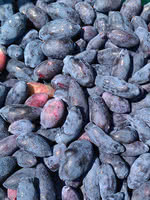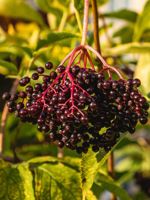Mon-Fri 9am - 5pm Mountain time
Blue Stuart Haskap (Honeyberry) vs Bob Gordon Elderberry
Lonicera caerulea Blue Stuart
Sambucus canadensis Bob Gordon
NOT AVAILABLE THIS SEASON - MIGHT RETURN
The Blue Stuart Haskap is a fruit-bearing shrub that produces medium-sized, oval-shaped and sweet berries. Their taste is typically described as something between a raspberry and a blueberry. The berries are ready for harvest through June and July, and are of medium firmness.
The Blue Stuart Haskap, or Blue Stuart Honeyberry is a cultivar of Russian origin bred by Lidia Stuart who grew up in far eastern Russia.
Blue Stuart is a late pollinating variety. Pair with other late pollinators to have a higher yield.
Blue Banana is a great companion variety.
Bob Gordon Elderberry is a Black Elderberry cultivar that produces berries that are larger and sweeter than other varieties, making it one of the top cultivars. It produces large clusters of white flowers that turn into large clusters of dark purple to black berries. The berries are well-suited for baked goods, jams, jellies, and syrups. It was selected from the wild in Missouri.
The large berry clusters that the Bob Gordon Elderberry produces will often end up hanging downward. This makes it more difficult for birds to feed on the berries. If birds are a concern, this might be the right berry for you.
Black Elderberries are considered to be partially self-pollinating. So while they will still produce some berries without cross-pollination, planting with another variety will increase yields. Consider planting with Black Elderberry or Ranch Elderberry.
Warning: the seeds, stems, leaves, roots, and uncooked berries are toxic to humans when eaten in quantity. Berries should be cooked to make them safe for human consumption.
Blue Stuart Haskap (Honeyberry) Quick Facts
Bob Gordon Elderberry Quick Facts
Toxicity: leaves, stems, and uncooked berries are poisonous to humans

